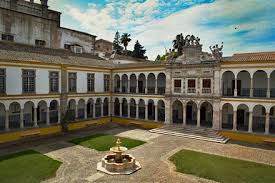
🏰 Hidden Gems of Portugal: Discovering Coimbra, Évora, and Lagos
When travelers think of Portugal, cities like Lisbon and Porto often dominate the spotlight. However, beyond the well-trodden paths lie hidden gems that offer equally fascinating histories, breathtaking architecture, authentic local experiences, and picturesque landscapes. Among these treasures are Coimbra, Évora, and Lagos — three cities that provide a deeper, more intimate glimpse into Portugal’s soul. In this article, we’ll explore what makes each of these cities stand out, their cultural traditions, gastronomy, accessibility, and why they deserve a spot on every traveler’s itinerary.
📚 Coimbra: The Intellectual Heart of Portugal
Nestled in central Portugal, Coimbra is often referred to as the country’s “university city,” home to one of the oldest universities in Europe — the University of Coimbra, founded in 1290. This city effortlessly blends academic legacy, medieval architecture, and youthful energy.
⭐ What to See in Coimbra:
-
University of Coimbra & Joanina Library: A UNESCO World Heritage Site, the university complex includes the Joanina Library, a baroque masterpiece with thousands of ancient volumes.
-
Sé Velha (Old Cathedral): Built in the 12th century, it showcases Romanesque architecture rarely seen in such fine preservation.
-
Botanical Garden: One of the oldest in Europe, offering a tranquil escape with exotic plants and shaded walkways.
🍽️ Local Traditions and Cuisine:
Coimbra is a haven for traditional fado music, particularly the Coimbra style sung by male students in black robes. For food lovers, chanfana (goat stew), leitão assado (roast suckling pig), and pastéis de Santa Clara (almond pastries) are must-tries.
🌦️ Weather & Accessibility:
Coimbra enjoys a temperate climate with warm summers and mild winters, making it suitable for year-round visits. It is well-connected by train from both Lisbon and Porto.
🏛️ Évora: A Living Museum of Portuguese History
Located in the Alentejo region, Évora is a UNESCO-listed city with more than 2000 years of history. It offers a compelling mix of Roman ruins, Gothic churches, and whitewashed houses within medieval walls.
⭐ Historical Highlights:
-
Roman Temple of Évora (Temple of Diana): One of the best-preserved Roman structures on the Iberian Peninsula.
-
Capela dos Ossos (Chapel of Bones): A chilling yet fascinating chapel lined with human bones and skulls, designed to inspire reflection.
-
Évora Cathedral: A stunning mix of Romanesque and Gothic architecture with panoramic views from its rooftop.
🍇 Cultural Experience:
Évora is deeply tied to Alentejo traditions, from slow-living lifestyles to winemaking. The region produces some of Portugal’s finest wines, olive oils, and cheeses. Markets here are vibrant and authentic, offering insight into local life.
🍴 Cuisine:
Signature dishes include açorda à alentejana (garlic and bread soup), migas (crumbs with pork), and ensopado de borrego (lamb stew). Paired with Alentejo wines, dining in Évora is a rich cultural immersion.
🌞 Climate & Travel:
Évora is known for its hot summers and mild winters. It’s about 90 minutes from Lisbon by car or bus, making it perfect for a short escape or a multi-day cultural journey.
🌊 Lagos: The Algarve’s Coastal Gem
In the sun-drenched Algarve region of southern Portugal lies Lagos, a city where history meets beaches, and nature embraces adventure. It’s ideal for both cultural tourism and relaxation by the sea.
⭐ Best Attractions in Lagos:
-
Ponta da Piedade: Stunning sea cliffs with grottoes and golden rock formations that are best explored by boat or kayak.
-
Praia do Camilo & Meia Praia: Pristine beaches perfect for sunbathing, swimming, and snorkeling.
-
Old Town Lagos: Cobbled streets, charming squares, and a mix of Moorish and Portuguese architecture offer a laid-back yet vibrant vibe.
-
Forte da Ponta da Bandeira: A 17th-century fort with sea views and historical exhibits.
🌍 Cultural Notes:
Lagos played a pivotal role during the Age of Discoveries. The Slave Market Museum reveals Portugal’s complex colonial history, providing deeper understanding for thoughtful travelers.
🐟 Food Scene:
As a coastal city, Lagos offers fresh seafood like grilled sardines, cataplana de marisco (seafood stew), and caldeirada (fish casserole). Pair with a local Vinho Verde or Algarve white wine for a perfect meal.
☀️ Weather & Accessibility:
Lagos enjoys over 300 sunny days a year, making it a favorite for beachgoers and digital nomads alike. It’s reachable via a 3-hour train ride from Lisbon, or shorter drives from other Algarve cities like Faro.
✈️ Practical Travel Tips
| Feature | Coimbra | Évora | Lagos |
|---|---|---|---|
| Best Time to Visit | Spring & Autumn | Autumn & Spring | Year-round |
| Recommended Stay | 2–3 days | 2 days | 4–5 days |
| Public Transport | Trains & buses | Buses from Lisbon | Trains, local buses |
| Budget Level | Mid-range | Affordable | Mid to high |
💡 Why Choose These Cities?

Each of these cities offers a distinct face of Portugal:
-
Coimbra connects you with the academic and philosophical roots of the nation.
-
Évora transports you through millennia of history and rural traditions.
-
Lagos invites you to relax by the sea while absorbing rich maritime heritage.
Together, they form a triangle of authenticity that showcases Portugal’s diverse beauty away from the crowds.
✅ Final Thoughts
Portugal’s charm extends far beyond Lisbon and Porto. Cities like Coimbra, Évora, and Lagos allow travelers to dive deeper into the country’s soul — discovering ancient universities, Roman temples, Moorish history, and some of Europe’s most beautiful coastlines. Whether you’re a history buff, a foodie, a beach lover, or simply seeking a quiet escape, these cities offer unforgettable experiences without the overwhelming crowds of more commercial destinations.
Pack your curiosity, embrace the slow pace, and let the hidden gems of Portugal surprise you.
Coimbra: Portugal’s Timeless University City and Cultural Jewel
Nestled along the winding Mondego River in central Portugal, Coimbra is a city where the past and present coexist in perfect harmony. Known primarily as the home of the University of Coimbra, one of the oldest in Europe, this enchanting city offers more than just academic prestige. Its cobbled streets echo centuries of intellectual pursuit, poetic legacy, and cultural richness. While often overshadowed by Lisbon or Porto, Coimbra stands as a serene yet vibrant destination that rewards travelers seeking authenticity, heritage, and heart.
In this article, we take a deep dive into what makes Coimbra a truly special city to visit—from its historical landmarks and student traditions to gastronomy, nature, and the rhythm of daily life.
🎓 A City of Knowledge: The University of Coimbra
At the heart of Coimbra’s identity is its prestigious University, founded in 1290 by King Dinis. It’s not only the oldest in Portugal but also one of the oldest continually operating universities in the world. In 2013, the University and its surrounding architecture were declared a UNESCO World Heritage Site.
📚 Must-See University Landmarks:
-
Joanina Library (Biblioteca Joanina): A baroque masterpiece from the 18th century, home to thousands of rare books and protected by resident bats that eat the insects harming manuscripts.
-
Royal Palace of Alcáçova: Once the residence of Portuguese kings, now part of the university’s main building.
-
Chapel of São Miguel: With its colorful azulejos and grand organ, this chapel is an unexpected gem inside the university complex.
The university’s student traditions also color the city. Black capes, the famous “Praxe” rituals, and the annual Queima das Fitas (Ribbon Burning) festival embody a rich academic culture still alive today.
🏰 Historical and Architectural Wonders
Beyond the university, Coimbra is a living museum of architectural periods, from Romanesque and Gothic to Manueline and Baroque styles.
🌟 Key Historical Sites:
-
Sé Velha (Old Cathedral): Built in the 12th century during the Reconquista, it’s one of the finest examples of Romanesque architecture in Portugal.
-
Sé Nova (New Cathedral): Formerly a Jesuit church, it features elegant baroque design.
-
Santa Clara-a-Velha Monastery: A hauntingly beautiful Gothic ruin once submerged by floods, it offers insight into the life of Queen Saint Isabel.
-
Monastery of Santa Cruz: Housing the tomb of Portugal’s first king, Afonso Henriques.
The city is also linked to Portugal’s royal and poetic past. Coimbra was once the capital of the country (1139–1255) and was the setting for the tragic love story of Pedro and Inês de Castro, often dubbed the “Portuguese Romeo and Juliet.”
🎶 Music, Culture & Traditions
Coimbra has a unique cultural fingerprint, and music plays a central role.
🎵 Coimbra Fado:
Unlike Lisbon’s melancholic fado sung by women, Coimbra fado is performed exclusively by men, traditionally university students, and has a more academic and poetic style. Performances often take place at night under archways or in intimate venues such as:
-
Fado ao Centro
-
À Capella
Traditional festivals like Queima das Fitas (in May) and Festa das Latas (in October) bring the city alive with parades, concerts, and student ceremonies.
🌿 Natural Beauty and River Charm
Coimbra’s location between hills and the Mondego River gives it a distinctive character. Strolling along the riverbanks or relaxing in green spaces offers a tranquil escape from urban buzz.
🌳 Parks and Gardens:
-
Jardim Botânico (Botanical Garden): Founded in 1772, this serene space is one of the oldest in Europe, home to exotic plants, fountains, and peacocks.
-
Choupal Forest: A beloved recreational area ideal for biking and jogging.
-
Pedro e Inês Pedestrian Bridge: A modern landmark with stunning views, named after the city’s iconic lovers.
🍷 Food and Wine of the Region
The Coimbra region is part of Beira Litoral, which influences its culinary identity. Expect rustic, hearty meals and time-honored cooking methods.
🍴 Signature Dishes:
-
Leitão à Bairrada: Suckling pig roasted in wood ovens, crispy on the outside and tender inside.
-
Chanfana: Goat slow-cooked in red wine and herbs.
-
Pastéis de Santa Clara: Sweet almond and egg yolk pastries originating from the convent.
Local wines from the Dão and Bairrada regions pair perfectly with traditional meals. Dining here is often a slow, social experience.
🛍️ Local Life, Markets & Handicrafts
Coimbra has a charming blend of student activity and slow, local life. The Baixa (downtown) area is ideal for shopping and mingling with locals.
🛒 Highlights:
-
Municipal Market (Mercado D. Pedro V): Fresh produce, fish, cheeses, and local goods.
-
Ceramics & Tiles: Coimbra is famous for its hand-painted blue and yellow ceramics.
-
Bookshops & Antique Stores: Hidden gems filled with rare finds.
🚆 Getting There and Around
Coimbra is conveniently located between Lisbon and Porto.
-
By Train: The city is connected by the Alfa Pendular high-speed train and Intercidades routes.
-
By Car: It’s a 2-hour drive from Lisbon or 90 minutes from Porto.
-
Getting Around: The city is walkable, though some areas involve uphill walking. Taxis, buses, and tuk-tuks are available.
📅 Best Time to Visit
-
Spring (April–June): Ideal temperatures and blooming gardens.
-
Autumn (September–October): Fewer crowds and pleasant weather.
-
Summer: Warm and lively, especially during festivals, though some parts can get hot.
🧳 Who Should Visit Coimbra?
-
Culture & History Buffs: For ancient architecture and literary legacy.
-
Students & Academics: As a study destination or for academic tourism.
-
Romantic Travelers: With its poetic vibe and love stories.
-
Slow Travelers: Those who appreciate local life and peaceful atmospheres.
✅ Final Thoughts: Why Coimbra Deserves Your Attention
Coimbra is more than just a university city. It’s a mosaic of Portugal’s intellectual, royal, religious, and cultural past, all tied together by a deep sense of identity and pride. Whether you’re exploring centuries-old libraries, listening to melancholic Coimbra fado under a moonlit archway, or savoring a hearty meal overlooking the river, Coimbra gives you a slice of Portugal that is as authentic as it is unforgettable.
For those willing to step off the beaten path, Coimbra offers a timeless journey through the heart of Portugal’s soul.